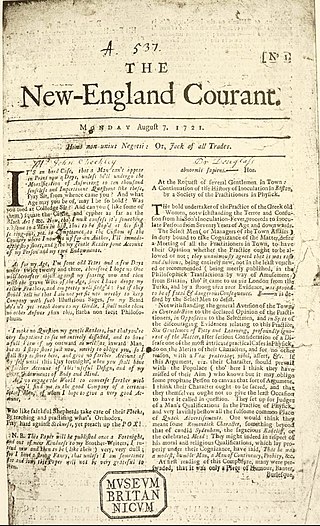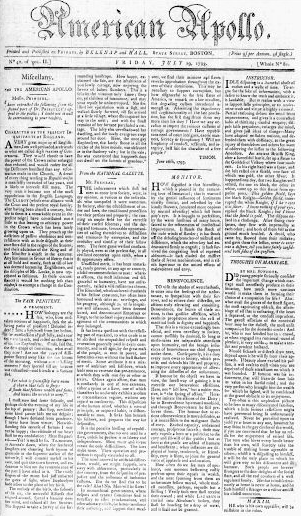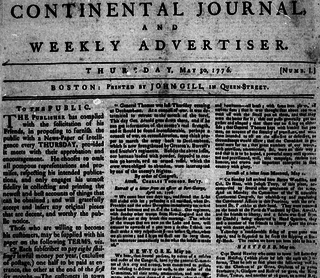History
Samuel Hall, at the age of twenty-six, announced that he was about to open a printing shop in Salem in April 1768. [1] Salem became the third place in the province of Massachusetts in which a press and a newspaper were established. [2] The Gazette's first issue was published August 2, 1768. [3] [lower-alpha 1] A copy of the first issue is preserved and housed at the Essex Institute in Salem. [5] At the commencement of its publication Hall on the front page of his Gazette declared his editorial policy, stating,
"I now commence the Publication of the ESSEX GAZETTE; ... I shall studiously avoid inserting any Pieces that can justly give Offence to Societies or Individuals: and with Regard to the Publishing of malicious personal Invectives, calculated to disturb the Peace and good Order of Society, or unjustly to injure the Character of any Individual, it is so repugnant to the Dictates of Justice, that no One, it is hoped, will be in the least apprehensive of its being practiced in this Gazette.
The Publick’s very humble,
And most obedient Servant,
Samuel Hall. [6]
Hall's policy, however, did not prevent him from voicing strong support for the patriot cause. On August 1, 1768, the Boston Non-importation agreement was signed by the majority of Boston's merchants, placing a boycott on imported British goods. Hall used The Essex Gazette throughout 1769 to identify and publicly condemn any merchants who failed to comply with the agreement. In December of that year, Hall named four residents of Marblehead, as merchants who ignored the agreement and continued to import goods from Britain. [7]
After the third year of the Gazette's publication, Hall took on his younger brother, Ebenezer, as a partner. The two published their newspaper in Salem until 1775, when they relocated the print shop to Cambridge. The newspaper supported the cause of the colonies against what was considered the unjust measures of the British Parliament. [8] [9] The frequent articles which appeared in the Gazette were from the hand of Whig writers, with some of them written with great force. [3]
On October 6, 1774 "The great Salem fire" destroyed the meeting house, numerous shops, homes and other structures in that city, including the Hall printing shop. [10] [lower-alpha 2] Hall was able to save his printing press and some other wares minutes before the fire reached and destroyed the shop. He subsequently moved his printing operation to a large brick building nearby, owned by a Mr. Blaney, which also contained the office of the Custom House. With the help of friends and neighbors Hall soon resumed printing the Gazette, where, in the issue immediately following the fire, Hall gave thanks and tribute to all who gave him their help and support. [12]
The Essex Gazette was issued for approximately seven years leading up to the Revolution, during a period when many significant events occurred. The burdensome taxes imposed by the King, the non-importation agreements, the Boston Massacre (1770), the Boston Tea Party (December 16, 1773), the 1774 Boston Port Act (one of five Intolerable Acts), the resultant town meetings, and the popular animosity and disregard for the British Crown and Parliament, were well covered by Hall's Gazette. Colonial historian Harriet Tapley notes that, "To scan the files is like reading at first hand the history of protesting Massachusetts during those years." [13]
Shortly after the American Revolutionary War broke out in Lexington and Concord (April 19, 1775), by the advice of various members of the Massachusetts General Court, and other prominent men of the Whig party, the Hall brothers moved from Salem to Cambridge at Stoughton Hall at Harvard College with their printing equipment and continued publication of the Gazette, under the new title of The New England Chronicle. [14] Hall, in May 1775, published a full account of the battle, along with an account of Leslie's invasion, in the Gazette. [15] The last issue printed at the Salem shop was dated, May 2, 1775. [16] The first issue appeared on May 12. This issue contained a letter from General Washington to various privately owned military companies in Virginia. [14] It also featured essays from various London newspapers, a patriotic article from the Connecticut Courant , [lower-alpha 3] and assorted interesting articles of literary significance, along with more than a page of advertisements, mostly from Boston merchants. [14] The Chronicle became an influential supporter of American independence. [17] Ebenezer died on February 14, 1776, with the next issue appearing on February 22, 1776, although Samuel's name did not appear in heading until the issue of February 29. [18] In 1776 the office, with its press and types, was again moved, this time to Boston. [17]

Daniel Fowle was a colonial American printer and publisher before and during the American Revolution, and the founder of The New Hampshire Gazette. He printed Samuel Adams' newspaper, The Independent Advertiser. He was jailed for printing a damaging account on the conduct of various Massachusetts representatives and after his trial, he lost his license to print. Dismayed with the Massachusetts government he subsequently chose to remove from Massachusetts to New Hampshire and established The New Hampshire Gazette. During the course of his printing career Fowle employed several apprentices. Using his newspaper, he openly criticized the Stamp Act in 1765. After American independence was established he was commissioned to print the state laws of New Hampshire.

The Boston Gazette (1719–1798) was a newspaper published in Boston, in the British North American colonies. It was a weekly newspaper established by William Brooker, who was just appointed Postmaster of Boston, with its first issue released on December 21, 1719. The Boston Gazette is widely considered the most influential newspaper in early American history, especially in the years leading up to and into the American Revolution. In 1741 the Boston Gazette incorporated the New-England Weekly Journal, founded by Samuel Kneeland, and became the Boston-Gazette, or New-England Weekly Journal. Contributors included: Samuel Adams, Paul Revere, Phyllis Wheatley.

Leverett Saltonstall, was a member of the United States House of Representatives from Massachusetts who also served as Speaker of the Massachusetts House of Representatives, President of the Massachusetts Senate, the first Mayor of Salem, Massachusetts and a Member of the Board of Overseers of Harvard College.

The Boston News-Letter, first published on April 24, 1704, is regarded as the first continuously published newspaper in the colony of Massachusetts. It was heavily subsidized by the British government, with a limited circulation. All copies were approved by the Royal governor before publication. The colonies’ first newspaper was Publick Occurrences Both Forreign and Domestick, which published its first and only issue on September 25, 1690. The Weekly Jamaica Courant followed in Kingston, Jamaica from 1718. In 1726 the Boston Gazette began publishing with Bartholomew Green, Jr., as printer.

The New-England Courant, one of the first American newspapers, was founded in Boston in 1721, by James Franklin. It was a weekly newspaper and the third to appear in Boston. Unlike other newspapers, it offered a more critical account about the British colonial government and other royal figures of authority. The newspaper published critical commentary about smallpox inoculation which fueled the controversy during the smallpox epidemic in Boston. Ultimately it was suppressed in 1726 by British colonial authorities for printing what they considered seditious articles. Franklin took on his brother, Benjamin Franklin, as an apprentice and at one point was compelled to sign over publication of the Courant to him to avert further prosecution. Benjamin submitted anonymous editorials to the Courant, which resulted in James' imprisonment after he began publishing them. This sort of Governmental censorship of early colonial newspapers is what largely fostered the American ideal of Freedom of Speech in the press. The New England Courant is widely noted among historians as being the first newspaper to publish Benjamin's writings.
The Boston Weekly Advertiser (1757–1775), also called The Boston Post-Boy & Advertiser was a weekly newspaper published in Boston, Massachusetts by John Green (1727–1787) and Joseph Russell (1734–1795).

The American Apollo was a newspaper published in Boston, Massachusetts in the late 18th century, featuring "political and commercial intelligence, and other entertaining matter." It was issued by printer Joseph Belknap, along with Alexander Young and Thomas Hall on State Street. In 1792, the newly formed Massachusetts Historical Society's "collections were at first published in ... the American Apollo. " The newspaper ceased in December 1794.

The Independent Chronicle (1776–1840) was a newspaper in Boston, Massachusetts. It originated in 1768 as The Essex Gazette, founded by Samuel Hall (v.1–7) in Salem, and The New-England Chronicle (v.7–9) in Cambridge, before settling in 1776 in Boston as The Independent Chronicle. Publishers also included Edward E. Powars, Nathaniel Willis, and Adams & Rhoades; Capt. Thomas Adams (ca.1757–1799) was the editor prior to his death in 1799. For some time it operated from offices on Court Street formerly occupied by James Franklin. As of the 1820s, "the Chronicle [was] the oldest newspaper ... published in Boston; and has long been considered one of the principal republican papers in the state; and its influence has, at all times, been in exact proportion to the popularity of the cause which it has so warmly espoused." After 1840 the paper continued as the Boston Semi-weekly Advertiser published by Nathan Hale.

John Gill (1732–1785) was a printer in Boston, Massachusetts, in the 18th century. With Benjamin Edes, he issued the Boston Gazette newspaper. He later published the Continental Journal between 1776 and 1785.

William Goddard was an early American patriot, publisher, printer and postal inspector. Born in New London, Connecticut, Goddard lived through the American Revolutionary era, during which he opposed British rule of the colonies through his actions and publications. He was a major figure in the development of the colonial postal system, which became the U.S. Post Office after the American Revolution.

Samuel Kneeland (c.1696–1769) was an American printer and publisher of The Boston Gazette and Weekly Journal. Kneeland obtained much of his work printing laws and other official documents for the Province of Massachusetts Bay colonial government for about two decades. He printed the first Bible in the English language ever produced in the American colonies, along with many other religious and spiritual works, including the Book of Psalms. He was also noted for introducing a number of innovations to newspaper printing and journalism. He was one of many colonial printers who were strongly opposed to and outspoken against the Stamp Act in 1765. Kneeland, primarily, along with his sons, were responsible for printing the greater majority of books, magazines and pamphlets published in Boston during his lifetime.
The Salem Philosophical Library (1781–1810) or Philosophical Library Company was a proprietary library in Salem, Massachusetts. Men affiliated with the library included: Tho. Bancroft, Thomas Barnard, William Bentley, Joseph Blaney, Nathaniel Bowditch, Manasseh Cutler, Nathan Dane, Joshua Fisher, Edward Augustus Holyoke, Joseph Mc'keen, B. Lynde Oliver, Joseph Orne, William Prescott, Samuel Page, Joshua Plummer, John Prince, Nathan Read, John D. Treadwell, Ichabod Tucker, and Joseph Willard. "The Library was kept at the house of Rev. Joseph Willard of Beverly, till ... December, 1781. ... His successor was Rev. Dr. Prince, who had the volumes at his mansion" in Salem. "By 1810, many of the members of the [Salem] Social Library also belonged to the Philosophical Library, and the two bodies were merged to create the Salem Athenaeum."

The Salem Observer (1823-1919) was a weekly newspaper published in Salem, Massachusetts. Among the editors: J.D.H. Gauss, Benj. Lynde Oliver, Gilbert L. Streeter, Joseph Gilbert Waters. Contributors included Wilson Flagg, Stephen B. Ives Jr., Edwin Jocelyn, E.M. Stone, Solomon S. Whipple. Publishers included Francis A. Fielden, Stephen B. Ives, William Ives, George W. Pease, Horace S. Traill. In the 1880s Elmira S. Cleaveland and Hattie E. Dennis worked as compositors. Its office was located in "'Messrs P. & A. Chase's ... brick building in Washington Street'" (1826-1832) and the Stearns Building (1832-1882). "In 1882 the proprietors erected the Observer Building, of three stories, of brick, in Kinsman Place next to the City Hall." As of the 1870s, one critic noted that although "the Observer is supposed to be neutral in politics, ... it has always shown unmistakable signs of a strong republican tendency."

The Salem Register was a newspaper published in Salem, Massachusetts, in the 19th century. William Carlton established it in 1800; subsequent publishers included his wife Elizabeth Carlton, John Chapman, Charles W. Palfray, Warick Palfray Jr., Haven Poole, Eben N. Walton. Among the contributing writers: William Bentley, Andrew Dunlap, Joseph E. Sprague, Joseph Story. Its office was at no.185 Essex Street.

Early American publishers and printers played a central role in the social, religious, political and commercial development of the Thirteen Colonies in British America prior to and during the American Revolution and the ensuing American Revolutionary War that established American independence.

The Massachusetts Gazette was a colonial American newspaper established by Richard Draper, printer for the royal governor and council in the Province of Massachusetts Bay. As the American Revolution drew closer, it was commissioned by the colonial government to lend its support for the measures of the British ministry. It was one of the few Loyalist newspapers operating during the years leading up to the revolution.
Thomas Fleet (1685–1758) was an English printer who came to the British colonies in America and established himself as a printer and publisher in Boston. His decision to come to the colonies was prompted by people seeking retribution for what was considered his public display of disrespect for a popular member of the English clergy. Fleet produced works for various booksellers, printed pamphlets, ballads, children's stories and later established the Boston Evening Post. In his earlier years fleet compiled his own version of Mother Goose from stories told by his mother-in-law, Elizabeth Vergoose, to his children. When he published various controversial accounts about the colonial government and the clergy he was admonished, threatened with prosecution and subsequently became one of the first American printers to challenge royal authority and defend the idea of Freedom of the Press. Through his newspaper Fleet played an active role in the Christian revivalist controversy that occurred in the colonies during the early eighteenth century.
Samuel Hall (1740-1807), was an Early American publisher and printer, newspaper editor, and an ardent colonial American patriot from Bedford, Massachusetts who was active in this capacity before and during the American Revolution, often printing newspapers and pamphlets in support of American independence. Hall was the founder of The Essex Gazette, the first newspaper published in Salem, Massachusetts in 1768. He often employed his newspaper as a voice supporting colonial grievances over taxation and other actions by the British Parliament that were considered oppressive, and ultimately in support of American independence.
Richard Draper (1726–1774) was an early American Boston printer and an editor of The Boston News-Letter. Together with his father and his nephew Draper printed and published The News-Letter. In the years leading up to the American Revolution Draper sided with the Loyalists and the Tory party, and through his newspaper he provided a voice for the Loyalist writers in Massachusetts and elsewhere.















